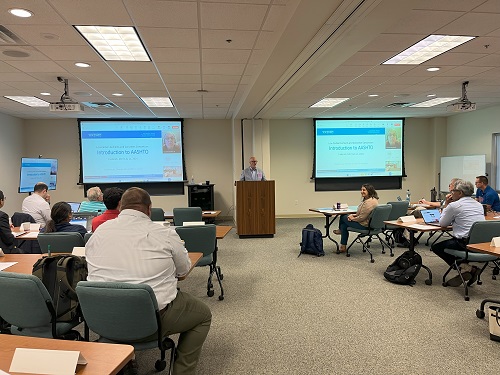AASHTO re:source recently hosted a meeting for the Low Carbon Cements and Concretes Consortium as part of a broader effort by the federal government to identify and address measurement and standards needs that can help reduce the overall greenhouse gas or GHG emissions from cement and concrete products.
[Above photo by AASHTO]
AASHTO re:source, a technical service program offered by the American Association of State Highway and Transportation Officials, delivers services and tools via three main programs: the Laboratory Assessment Program, the Proficiency Sample Program, and the AASHTO Accreditation Program.
Through these initiatives, along with knowledge sharing and training events, AASHTO re:source assesses testing competency, promotes continual improvement, and builds trust and confidence among laboratories and program users.

Attendees at the consortium meeting include representatives from the National Institute of Standards and Technology or NIST; the Federal Highway Administration; the American Concrete Institute; the U.S. Department of Energy; the National Ready Mixed Concrete Association; the Portland Cement Association; the Concrete Masonry & Hardscapes Association; and the National Institute of Building Sciences.
The goals of the consortium focus on four points: Evaluate the suitability of current standards to measure carbon emissions; accurately measure carbon uptake during the “curing” of various concrete products; evaluate the applicability of current test methods; and propose new test methods in order to enable acceptance of new materials.
Bob Lutz, AASHTO re:source director, spoke at the meeting and stressed how the consortium’s focus on lowering carbon emissions from the concrete production sector “aligns with AASHTO’s vision of providing improved quality of life for transportation system users, as well as AASHTO’s mission of shaping what the future transportation systems will be.”
He noted that the AASHTO Committee on Materials and Pavements also develops national testing standards – especially for cement and concrete specifications applicable to transportation – and will work closely with AASHTO re:source’s programs as part of an “integral step” in the implementation of new low-carbon cement and concrete standards.
“The efforts of the consortium also align with our mission of collaborating with key transportation sector stakeholders to provide services that ensure the integrity of the materials in our nation’s infrastructure,” he added. “That integrity is dependent on the robustness of any new low-carbon cement and concrete standards.”
 AASHTO
AASHTO
Success of Virtual ‘TechEx’ Complements In-Person Meeting
December 19, 2025 AASHTO
AASHTO

